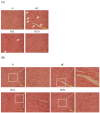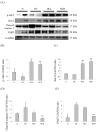Heat-killed Lactobacillus Reuteri GMNL-263 Prevents Epididymal Fat Accumulation and Cardiac Injury in High-Calorie Diet-Fed Rats
- PMID: 27499689
- PMCID: PMC4974905
- DOI: 10.7150/ijms.15597
Heat-killed Lactobacillus Reuteri GMNL-263 Prevents Epididymal Fat Accumulation and Cardiac Injury in High-Calorie Diet-Fed Rats
Abstract
High-calorie diet-induced obesity leads to cardiomyocyte dysfunction and apoptosis. Impaired regulation of epididymal fat content in obese patients has been known to increase the risk of cardiac injury. In our study, a lactic acid bacteria, Lactobacillus reuteri GMNL-263, was evaluated for its potential to reduce body weight and body fat ratio and to prevent heart injury in rats with high-fat diet-induced obesity. Lactic acid bacteria supplementation restored the cardiac function and decreased the physiological changes in the heart of the obese rats. In addition, the Fas/Fas-associated protein pathway-induced caspase 3/e Poly polymerase mediated apoptosis in the cardiomyocytes of the obese rats was reversed in the Lr263-treated rats. These results reveal that fed with Lr-263 reduces body fat ratio, inhibits caspase 3-mediated apoptosis and restores cardiac function in obese rats through recovery of ejection fraction and fractional shortening. Our results indicated that the administration of Lr263 lactic acid bacteria can significantly down-regulate body fat and prevent cardiomyocyte injury in obese rats.
Keywords: Cardiac dysfunction; Functional food; High-calorie diet; Obesity.
Conflict of interest statement
Competing Interests: The authors have declared that no competing interest exists.
Figures



Similar articles
-
Diabetes-induced cardiomyopathy is ameliorated by heat-killed Lactobacillus reuteri GMNL-263 in diabetic rats via the repression of the toll-like receptor 4 pathway.Eur J Nutr. 2021 Sep;60(6):3211-3223. doi: 10.1007/s00394-020-02474-z. Epub 2021 Feb 8. Eur J Nutr. 2021. PMID: 33555373
-
Supplementary heat-killed Lactobacillus reuteri GMNL-263 ameliorates hyperlipidaemic and cardiac apoptosis in high-fat diet-fed hamsters to maintain cardiovascular function.Br J Nutr. 2015 Sep 14;114(5):706-12. doi: 10.1017/S0007114515002469. Epub 2015 Aug 3. Br J Nutr. 2015. PMID: 26234728
-
Heat-killed and live Lactobacillus reuteri GMNL-263 exhibit similar effects on improving metabolic functions in high-fat diet-induced obese rats.Food Funct. 2016 May 18;7(5):2374-88. doi: 10.1039/c5fo01396h. Epub 2016 May 10. Food Funct. 2016. PMID: 27163114
-
Heat Killed Lactobacillus reuteri GMNL-263 Reduces Fibrosis Effects on the Liver and Heart in High Fat Diet-Hamsters via TGF-β Suppression.Int J Mol Sci. 2015 Oct 28;16(10):25881-96. doi: 10.3390/ijms161025881. Int J Mol Sci. 2015. PMID: 26516851 Free PMC article.
-
Hyperglycemia-Induced Cardiac Damage Is Alleviated by Heat-Inactivated Lactobacillus reuteri GMNL-263 via Activation of the IGF1R Survival Pathway.Probiotics Antimicrob Proteins. 2021 Aug;13(4):1044-1053. doi: 10.1007/s12602-021-09745-z. Epub 2021 Feb 1. Probiotics Antimicrob Proteins. 2021. PMID: 33527184
Cited by
-
Interactions between the gut microbiome, associated metabolites and the manifestation and progression of heart failure with preserved ejection fraction in ZSF1 rats.Cardiovasc Diabetol. 2024 Aug 14;23(1):299. doi: 10.1186/s12933-024-02398-6. Cardiovasc Diabetol. 2024. PMID: 39143579 Free PMC article.
-
Dietary novel alkaline protease from Bacillus licheniformis improves broiler meat nutritional value and modulates intestinal microbiota and metabolites.Anim Microbiome. 2024 Jan 6;6(1):1. doi: 10.1186/s42523-023-00287-z. Anim Microbiome. 2024. PMID: 38184648 Free PMC article.
-
Fermentation improves flavors, bioactive substances, and antioxidant capacity of Bian-Que Triple-Bean Soup by lactic acid bacteria.Front Microbiol. 2023 Jul 18;14:1152654. doi: 10.3389/fmicb.2023.1152654. eCollection 2023. Front Microbiol. 2023. PMID: 37533834 Free PMC article.
-
Effects of blended microbial feed additives on performance, meat quality, gut microbiota and metabolism of broilers.Front Nutr. 2022 Dec 6;9:1026599. doi: 10.3389/fnut.2022.1026599. eCollection 2022. Front Nutr. 2022. PMID: 36562042 Free PMC article.
-
Diabetes-induced cardiomyopathy is ameliorated by heat-killed Lactobacillus reuteri GMNL-263 in diabetic rats via the repression of the toll-like receptor 4 pathway.Eur J Nutr. 2021 Sep;60(6):3211-3223. doi: 10.1007/s00394-020-02474-z. Epub 2021 Feb 8. Eur J Nutr. 2021. PMID: 33555373
References
-
- Chen PY, Lu ML, Huang MC, Kao CF, Kuo PH, Chiu CC. et al. The Relationships of Obesity-Related Genetic Variants With Metabolic Profiles and Response to Metformin in Clozapine-Treated Patients With Schizophrenia. Journal of clinical psychopharmacology. 2015;35:574–8. - PubMed
-
- Hedley AA, Ogden CL, Johnson CL, Carroll MD, Curtin LR, Flegal KM. Prevalence of overweight and obesity among US children, adolescents, and adults, 1999-2002. Jama. 2004;291:2847–50. - PubMed
-
- Kuczmarski RJ, Flegal KM, Campbell SM, Johnson CL. Increasing prevalence of overweight among US adults. The National Health and Nutrition Examination Surveys, 1960 to 1991. Jama. 1994;272:205–11. - PubMed
MeSH terms
LinkOut - more resources
Full Text Sources
Other Literature Sources
Medical
Research Materials
Miscellaneous

